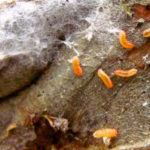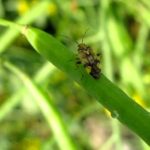Harvest 2016 continued across Manitoba, although wet weather, shorter days and heavy morning dews are impacting the number of acres harvested in any given day. Many crops are being harvested at tough or damp moisture levels, requiring aeration or artificial drying to achieve safe storage moisture levels. Some areas reported light frost events Thursday and
Manitoba Crop Report and Crop Weather report: No. 21
Conditions as of September 19, 2016
Manitoba Crop Report and Crop Weather report: No. 20
Conditions as of September 12, 2016
Wet weather over the past week slowed harvest progress in Manitoba. The recent weather is also impacting crop quality in spring wheat and barley. Some crops are being harvested at tough or damp moisture levels, requiring aeration or artificial drying to achieve safe storage moisture levels. Soybeans, grain corn and sunflowers are maturing quickly. Silage
Manitoba Crop Report and Crop Weather report: No. 19
Conditions as of September 6, 2016
Harvest 2016 continued across Manitoba with good progress made in cereal crops and canola. However, wet weather over the weekend in some areas of the province impacted harvest operations. Harvest will resume quickly in areas that received lower rainfall amounts and where field conditions allow. Field operations will be delayed in areas that received significant
Manitoba Crop Report and Crop Weather report: No. 18
Conditions as of August 30, 2016
Harvest 2016 continued across Manitoba. There were challenges due to wet weather and field conditions in some areas, as well as high grain moisture contents. To date, spring wheat yields range from 30 to 90 bushels per acre, barley 60 to 100 bushels per acre, oats 80 to 175 bushels per acre, field peas 15
Manitoba Crop Report and Crop Weather report: No. 17
Conditions as of August 22, 2016
Sporadic rainfall, high humidity and wet field conditions have slowed harvest progress in areas of Manitoba. However, harvest does continue as weather and field conditions allow. Winter wheat and fall rye harvest is complete. Winter wheat yields range from 50 to 100 bushels per acre, with an estimated provincial average of 75 bushels per acre.

Crop insect concerns low, some soybean crops report brown spot
Manitoba Insect and Disease summary for August 17
Summary Insects: Insect pest concerns are currently low. Most canola crops are now past the stage where Lygus bugs would be of concern. Only trace levels of soybean aphids have been found so far. Grasshopper counts have so far generally been low. Plant pathogens: Various diseases continue to be reported in field crops.. Disease Update Corn:
Manitoba Crop Report and Crop Weather report: No. 16
Conditions as of August 15, 2016
Crops are maturing rapidly across Manitoba. The 2016 harvest was slowed by the continuing wet conditions in some areas of Manitoba. However, harvest operations did occur where field and weather conditions allowed. Harvest of winter wheat, fall rye, spring wheat, barley, oats and field peas continues. To date, reported winter wheat yields range from 50

Lygus bugs, moths present in sunflowers, keep your eye on stored grain
Manitoba Insect and Disease summary for August 10
Summary Insects: Insects of highest importance to scout for currently are Lygus bugs in canola and sunflowers, and banded sunflower moths in sunflowers. Only trace levels of soybean aphids have been found so far. There have still been no reports of high levels of larvae of bertha armyworms in Manitoba. Plant Pathogens: Various diseases continue
Manitoba Crop Report and Crop Weather report: No. 15
Conditions as of August 8, 2016
Strong weather systems passed through several areas of Manitoba throughout the week. Heavy rains and strong winds halted harvest operations and resulted in lodging of crops.However, harvest did resume where field and weather conditions allowed. Winter wheat yields are ranging from 50 to 95 bushels per acre, with good quality reported to date. Swathing or

Time to scout for lygus bugs in canola and sunflower crops
Manitoba Insect and Disease summary for August 3
Summary Insects: Insects of highest importance to scout for currently are Lygus bugs in canola and sunflowers, and banded sunflower moths in sunflowers. Only trace levels of soybean aphids have been found so far. Although a couple of traps monitoring adults of bertha armyworm had moderate counts in the Northwest, and a few traps had counts in the uncertain risk

